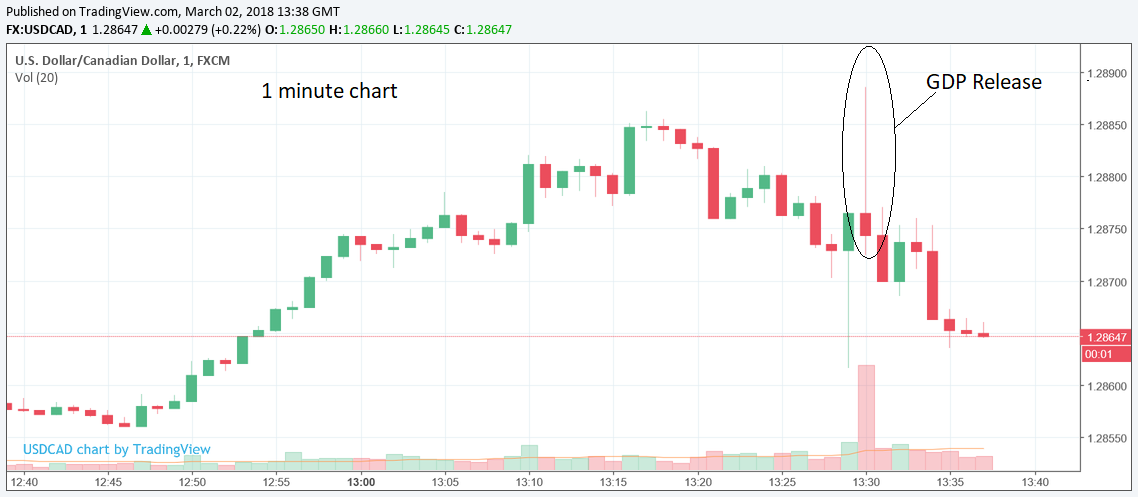Canadian Dollar Sinks Versus Pound After Release of Q4 GDP Data

© Viv Idrange, Adobe Stock
Traders continued selling the Canadian Dollar after the release of Q4 GDP undershot expectations on Friday.
The Pound rose versus the Canadian Dollar on Friday after traders sold the latter due to lower-than-expected growth in Q4 following the release of figures which showed the economy grew by only 1.7% compared to the year before, undershotting, substantially, forecasts which has expected a 2.0% growth rate.
The previous quarter's growth rate was also revised down to 1.5% from a first estimate of 1.7% but the growth rate for 2018 came in at a higher-than-expected 3.0%, providing the data with its silver lining.
GBP/CAD reacted by rising initially as can be seen on the 1 minute chart of the pair below - rising from a pre-release 1.7730 to a peak of 1.7770 before easing back down again.
USD/CAD reacted in a more volatile way, also rising initially as the data weighed on the outlook for CAD, but then rapidly giving up those loses as can also be seen on the chart below.
The more posiitve reaction versus the US Dollar falls in line with the "sell the rumour, buy the fact" forecast of some analysts, such as ACLS Global chief strategist Marshall Gittler.
Despite the poor headline figure, "Final domestic demand - what Canadians are buying - remained hot at a 3.9% pace in Q4, matching Q3," says CIBC Economics economist Avery Shenfield in a note immediately after the releases, in which he added,"The moderate pace to Q4 owed to a period of weaker inventory accumulation and, as in Q3, a larger gain in imports (i.e. more of the demand going to foreign suppliers) than exports. Looks like there were upward revisions to prior quarters, as the full year came in at 3.0% (we were looking for 2.9%)."
Multiple Headwinds
The Canadian Dollar is facing many headwinds at the moment so it is unlikely to strengthen much after the result.
Much of the blame for Canadian Dollar weakness has been put at the door of the US threatening to apply trade tariffs to steel and aluminum imports, a substantial amount of which come from Canada.
Another reason was data out on Thursday which showed a fall in foreign purchases of Canadian financial assets including bonds.
A fall in demand for Canadian assets could weigh on the Canadian Dollar which might need to depreciate to entice foreigners to continue buying and/or lending the country money.
This is particularly true in light of Canada's C$-3.2bn trade deficit which probably will need outside financing to cover, normally via the sale of Canadian bonds.
"Yesterday’s balance of payment data illustrated that foreign direct investment in Canada has fallen further, which underlines the major risks for the Canadian economy arising from a renewed correction of the oil price and the possible failure of the NAFTA negotiations, as portfolio investments to finance its current account deficit can be withdrawn much more easily," says Commerzbank analyst Esther Reichelt.
The risks to the trade deficit widening even further are also growing, firstly from oil prices falling, given crude is the country's largest export, and second from the possible introduction of punitive trade tariffs from the US.
Yet despite increasing risks that NAFTA will unravel, Commerzbank's base case is that it still remains in everyone's interests to persevere with NAFTA.
Given the positive economic outlook, the Bank of Canada (BOC) are more likely to raise interest rates than cut them in the future, which would be positive for the CAD - if not at next week's meeting then probably further down the line.
"In view of the decent economic environment the path would then be clear for further BoC rate hikes - probably not at next week’s meeting, but during the course of the year. The USD-CAD exchange rate is then likely to be capped in the area just above 1.29," says the Commerzbank analyst.
Get up to 5% more foreign exchange by using a specialist provider to get closer to the real market rate and avoid the gaping spreads charged by your bank when providing currency. Learn more here.












